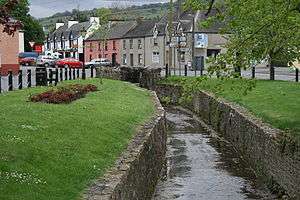Kinnitty
Kinnity is a village in County Offaly, Ireland. It is located 13 km east of Birr on the R440 and R421 regional roads.

The village derives its name from the myth that the head of an ancient princess is buried beneath the village, Ceann being Irish for head and Eitigh being the name of the princess. The village is situated in a picturesque setting at the foot of the Slieve Bloom Mountains. Like any typical Irish village it has two pubs (Slieve Bloom Bar & Clendennen's), two churches, a post office and some shops. However unlike any Irish village it has a pyramid which was built by the Bernard family who resided in Kinnitty Castle, which they built on the site of St. Finnians monastery, the high cross of which is still situated on the site. The pyramid can be seen by entering the grounds of the Church of Ireland, and following the walkway in the back.
Get in
By car
From Tullamore or from the Slieve Bloom Mountains
Get around
Walk or Cycle
See
- Kinnity Castle (north of the Slieve Bloom Mountains on the R421 regional road between the villages of Kinnitty and Cadamstown). The castle is built on the site of St. Finnian's monastery, the high cross of which is still situated nearby. Later, a pyramid was built by the Bernard family who resided in Kinnitty Castle.
Do
- Hill Climbing, Slieve Bloom. Climb the nearby Slieve Bloom Mountains.
Buy
- Peavoys Shop. Little shop in the centre
- Late Late Shop.
Eat
- Kinnitty Castle. There is a restaurant in Kinnitty Castle. It might be open or not. You'll probably have to go to the door and ask.
Drink
- Slieve Bloom Bar. Drink Guinness or whatever.
- Clendennen's. Drink more Guinness.
Sleep
- Ardmore Country House B&B, The Walk Kinnitty, ☎ +353 57 913-7009, +353 86 278-9147 (mobile). B&B where you can sleep for the night. Near Slieve Bloom Mnts.
Connect
Go next
Go out of the town and see the Slieve Bloom Mountains.